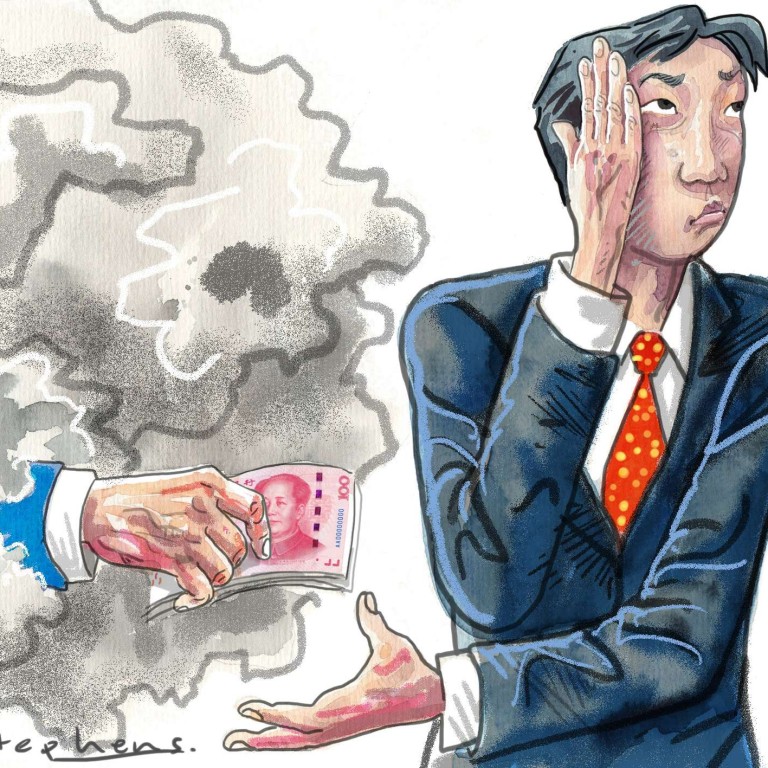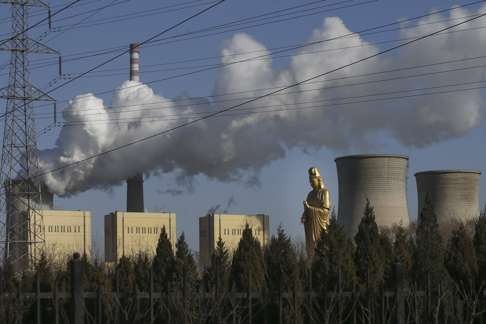
China’s power struggle: how Beijing’s clean-energy efforts are being frustrated by local officials
Wenyuan Wu says there is a severe mismatch between national carbon emission goals and divergent local interests

On paper, provinces seem to be following the central government’s lead. Earlier this year, China’s National Bureau of Statistics reported a 3-4 per cent fall in fossil carbon dioxide emissions in 2015. In June alone, China’s biggest coal-producing province, Shanxi (山西), shut down over a dozen chemical plants and issued 9.17 million yuan (HK$10.69 million) in fines.
Nonetheless, the success of the Communist Party’s anti-pollution regime is more elusive than proclaimed.

Exposure to air pollution raises your blood pressure, Chinese study shows
China has topped the global list of carbon emitters since 2007 and produces almost twice as much pollution as the US. According to a 2015 Harvard University report on emissions, China released approximately 8.5 gigatonnes of carbon in 2012, 85 per cent of which originated from manufacturing and power generation. Even these outlandish figures represent only a watered-down version of reality. The National Sierra Club estimates China burns 17 per cent more coal than officially stated, and claims that as few as 21 individuals account for a tenth of the nation’s overall emissions.
At its heart, China’s persistent carbon emissions problem arises from mismatches between the central government’s top-down approach to fighting industrial pollution and divergent local interests.
Based on the national plan, Beijing has committed itself to clipping 45 per cent of carbon intensity (carbon emissions as a percentage of GDP) by 2020. Beijing’s primary method is to assign similar emission reduction quotas to each province. For example, from 2010 to 2015, Shanxi was mandated to take charge of a 16 per cent reduction while less-polluted Yunnan (雲南) was given a similar goal of 15 per cent. These standardised indicators mirror Beijing’s one-size-fits-all vision, far removed from facts on the ground in different regions. This creates incentives for local governments and businesses to cheat.

Chinese cement factory takes ministry to court in pollution battle
According to a source in a spray-coating factory in Jiangsu (江蘇), the mounting difficulties of acquiring new environmental certification are the biggest challenge for local manufacturers nowadays – but major loopholes can be used to bypass regulations. With the acquiescence of local governments, chemical companies can avoid the environmental review process by falsely registering with the local bureau of commerce as something less environmentally sensitive, such as a finance or equipment trading firm. On the other hand, China’s unique structure of layered bureaucracies with ambiguous functions impedes coordination between agencies and creates wiggle room for polluting businesses. After all, the bureaus of commerce and industry are only interested in imposing financial discipline and avoid any involvement with environmental issues.
Local governments often have to choose between economic development and environmental preservation
Juggling a myriad of tasks from Beijing, local governments often have to choose between economic development and environmental preservation. In most cases, they prioritise the former. In coastal provinces, where waves of migration brought former rural residents to work in industry, local policymakers find it politically unsettling to risk consolidations, layoffs and potential civil unrest by transforming coal-powered factories to run on clean energy.
The mismatch between national energy goals and local policymaking is especially acute in the power generation sector. In the first three quarters of 2015, environmental protection agencies in various provinces granted 155 permits to build coal-fired power plants. If fully operational, these plants could add 123 gigawatts worth of coal power capacity and emit 560 million tonnes of carbon dioxide. This local surge exacerbates China’s oversupply of coal and coal-fuelled electricity, distorts market mechanisms and crowds out development of renewable energy sources.
Encouraged by local authorities to boost employment and short-term GDP growth, the glut of coal power plants runs counter to the central government’s pledge to develop sustainable energy and, among other issues, powers overproduction of commodities in excess of what markets can absorb. In the case of steel and aluminium, those surpluses have driven down global prices and prompted an outcry from American and European officials, embroiling China in disputes with important partners.
These divergent priorities pull local governments away from Beijing and toward local businesses, sometimes by means of collusion.

China orders checks on energy use to speed up closure of inefficient coal mines and steel plants: economic watchdog
For example, to combat industrial carbon emissions, the central government requires factories to install natural gas industrial burners to replace coal. This measure is impractical, because many industrial compounds were not built with natural gas pipelines and those with gas access are discouraged by the cost (about 300,000 yuan per burner). Only a few metropolitan areas, like Beijing, subsidise these costs. Facilities that lack the infrastructure to build pipelines often resort to gasoline as a replacement option. Local governments generally accept temporary, partial conversions to gasoline burners as a cost-effective interim solution, even though this runs counter to Beijing’s preference for natural gas. The spray-coating factory in Jiangsu, for one, partially converted its burner to use gasoline and coal while its owner spends a good portion of his time with local environmental officials at expensive restaurants (a common practice of the local business circle). That relationship offers easy access to sensitive information. In its daily operations, the factory runs on coal but switches to gasoline when informed of an inspection by “friendly” local officials.
The grim local realities defy Beijing’s idea of substantively reducing carbon emissions
The grim local realities defy Beijing’s idea of substantively reducing carbon emissions, a top-down agenda disconnected from the perverse local culture of subtle corruption, informality and ingrained “folk wisdom”.
While a comprehensive solution would require totally reorienting China’s development model, incremental changes should start with reforming the ineffective, centralised regime of environmental protection by allowing local civic participation to identify problems and create much-needed checks and balances. Although most NGOs are at least partially government-sponsored, China’s new environmental law boosts the powers of environmental organisations by allowing them, for the first time, to file litigation against polluting companies.
Shortly after the law’s enactment in 2014, the Guangdong Environmental Protection Fund won a 410,600 yuan lawsuit against an electroplate factory for water contamination. Earlier this month, prosecutors successfully sued local environmental officials in Shandong (山東) province for failing to properly punish a chemicals company caught producing dyes without the required safety measures. While these cases serve as positive milestones, curtailing pollution requires grander transformations.
Wenyuan Wu is a doctoral candidate in international studies at the University of Miami. Her research covers governance and energy reform issues in China and Latin America

